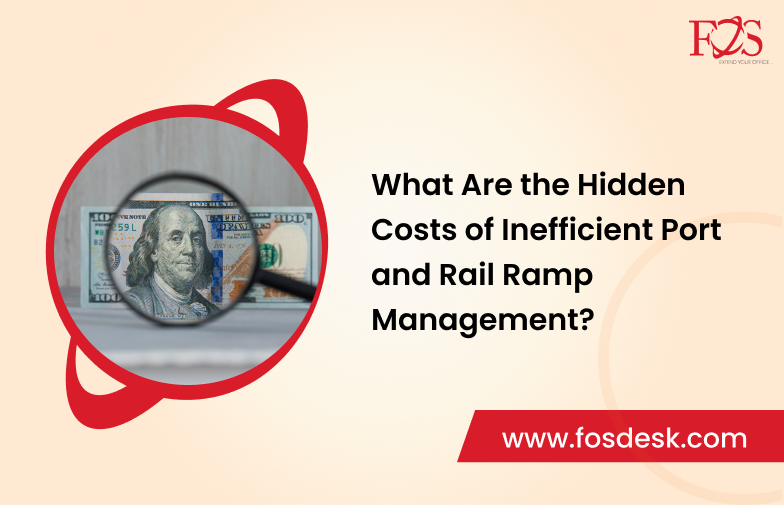In logistics, efficiency is a cost-cutting tactic as much as a desired outcome. Here is the catch, even if your shipments are in motion, your budget may be subtly drained by unnoticed inefficiencies at the port and train terminal. These problems are frequently overlooked until they manifest as higher expenses on your balance sheet. If you oversee the logistics budget or general profitability of your business, being aware of these hidden expenses could ultimately save you a lot of money.
Why Port and Rail Ramp Operations Deserve Your Attention
Port and rail ramp operations are the first and last touchpoints for cargo moving through multimodal transport. A small delay at the port or a backlog at a rail ramp can create a ripple effect, impacting your entire supply chain. The result? Unplanned costs and unhappy customers.
Why Port and Rail Ramp Operations Are Critical to Your Bottom Line
In the U.S., major ports like Los Angeles, Long Beach, and Savannah handle massive container volumes daily. Add to that the expansive rail network led by BNSF, Union Pacific, and CSX, and it becomes clear that port and rail ramp operations are key players in your logistics pipeline.
In addition to interfering with delivery, a delay or error at any of these nodes results in hidden expenses that are frequently overlooked in high-level financial reviews.
Time Is Money—and Delays Are Expensive
We’ve all heard the phrase, but when it comes to port and rail logistics, it hits hard. Every extra hour your cargo spends waiting at a port terminal or rail yard racks up fees, impacts your downstream operations, and slows your time-to-market.
A 2023 report from the Bureau of Transportation Statistics noted that port dwell times in the U.S. increased by an average of 18% post-pandemic. For high-volume shippers, even a few hours of delay can translate into tens of thousands of dollars in overtime pay, lost sales, or expedited transport costs.
The Silent Drain: Storage and Dwell Fees
There is typically a 4- to 5-day grace period for container pickup at the majority of U.S. ports. Daily storage costs, however, can easily get out of hand after that. Dwell fees at big ports, such as LA and NY/NJ, can surpass $150 per container each day.
These charges often get buried in carrier invoices and go unnoticed until they inflate your monthly freight spend.
Demurrage and Detention: Penalties That Hurt
Among the most agonizing hidden fees are detention and demurrage charges. The average U.S. shipper pays between $300 and $600 per container in demurrage each year, whether the containers are held at the port because of missed appointments or delays in returning the chassis to the terminal. Only with close collaboration and real-time awareness are these expenses preventable.
Labor and Overhead: The High Cost of Manual Coordination
If your team is still managing port and rail ramp operations with spreadsheets, emails, and calls, you’re spending more than just time. You’re allocating expensive labor hours toward tasks that could be outsourced or automated.
This is where Logistics BPO services shine. By outsourcing coordination, document processing, and appointment scheduling, companies have reported a 30–40% reduction in back-office labor costs.
Underutilized Assets = Wasted Investment
Every idle chassis, railcar, or trailer is an asset not deliver value. Poor port and ramp management often means equipment sits unused, waiting for clearance or scheduling. This leads to higher leasing costs, unnecessary repositioning fees, and even customer chargebacks when SLAs aren’t met.
Reputational Damage = Long-Term Losses
Contract cancellations and lost revenue might result from a single delayed delivery. Reliability is crucial, particularly for business-to-business (B2B) activities. Your customers and their procurement teams will notice if you are frequently late because of port or ramp inefficiencies.
Poor ESG Metrics and Carbon Penalties
Idle trucks waiting for containers? Are railcars idling due to backup at the ramp? You’re burning fuel, not just cash. With a growing emphasis on sustainability, inefficient logistics can tank your ESG scores and impact how institutional clients view your brand.
The Environmental Protection Agency (EPA) estimates that around 12% of CO2 emissions from the US transportation sector are caused by idle freight activities. That is a commercial risk as well as a climatic one.
Insurance Premiums on the Rise
Frequent delays, lost containers, or increased theft during dwell periods all raise red flags for insurers. You may start to see rising premiums and stricter terms, especially if you can’t show clear documentation of how you manage these risks.
Data Gaps and Poor Forecasting
When port and rail costs are not properly tracked or categorized, your forecasts become inaccurate. That impacts budget planning, ROI analysis, and even shareholder confidence. You can’t manage what you don’t measure, and logistics is no exception.
The Solution? Logistics BPO Services That Specialize in U.S. Operations
Partnering with a U.S.-compliant Logistics BPO service gives you access to trained professionals who understand port and rail ramp processes, carrier SLAs, and customs requirements. You also get centralized communication, proactive updates, and real-time issue resolution.
Companies using Logistics BPOs have reported:
- Shorter port dwell times
- Fewer demurrage penalties
- More accurate ETAs and customer updates
- 25–35% cost reduction in total logistics spend
Technology as a Game Changer
Digital freight platforms, AI-powered visibility tools, and automated dispatch systems are redefining how port and rail ramp operations are managed. U.S. companies that invest in tech-driven logistics solutions not only cut costs but also gain a competitive edge in predictability, compliance, and customer satisfaction.
Real-World Scenario: The Domino Effect of One Delay
Picture this: Your container arrives at the Port of Long Beach, but the paperwork isn’t complete. The terminal won’t release it. By the time it’s cleared, your rail booking is missed. Now you’re paying storage, rebooking fees, and premium freight to get it back on schedule.
This is not an isolated incident; it occurs daily throughout the United States and costs American companies billions of dollars every year.

Conclusion
Your logistics might look smooth on paper, but unless you’re actively managing port and rail ramp operations, you’re leaking money. These hidden costs affect your financial performance, your service levels, and even your brand perception.
This is not an isolated incident; it occurs daily throughout the United States and costs American companies billions of dollars every year.
FAQs
1. What are typical hidden costs in U.S. port and rail ramp operations?
Common hidden costs include port storage fees, demurrage, detention charges, missed rail bookings, labor overhead, and last-minute freight surcharges.
2. How do Logistics BPO services help U.S. companies?
They handle documentation, appointment setting, and coordination with U.S. carriers, ports, and customs, helping companies reduce penalties and streamline their entire freight flow.
3. Is investing in port and ramp management tools worth it for U.S. businesses?
Absolutely. These tools improve transparency, reduce manual work, and allow for smarter forecasting—ultimately saving money and improving service quality.
